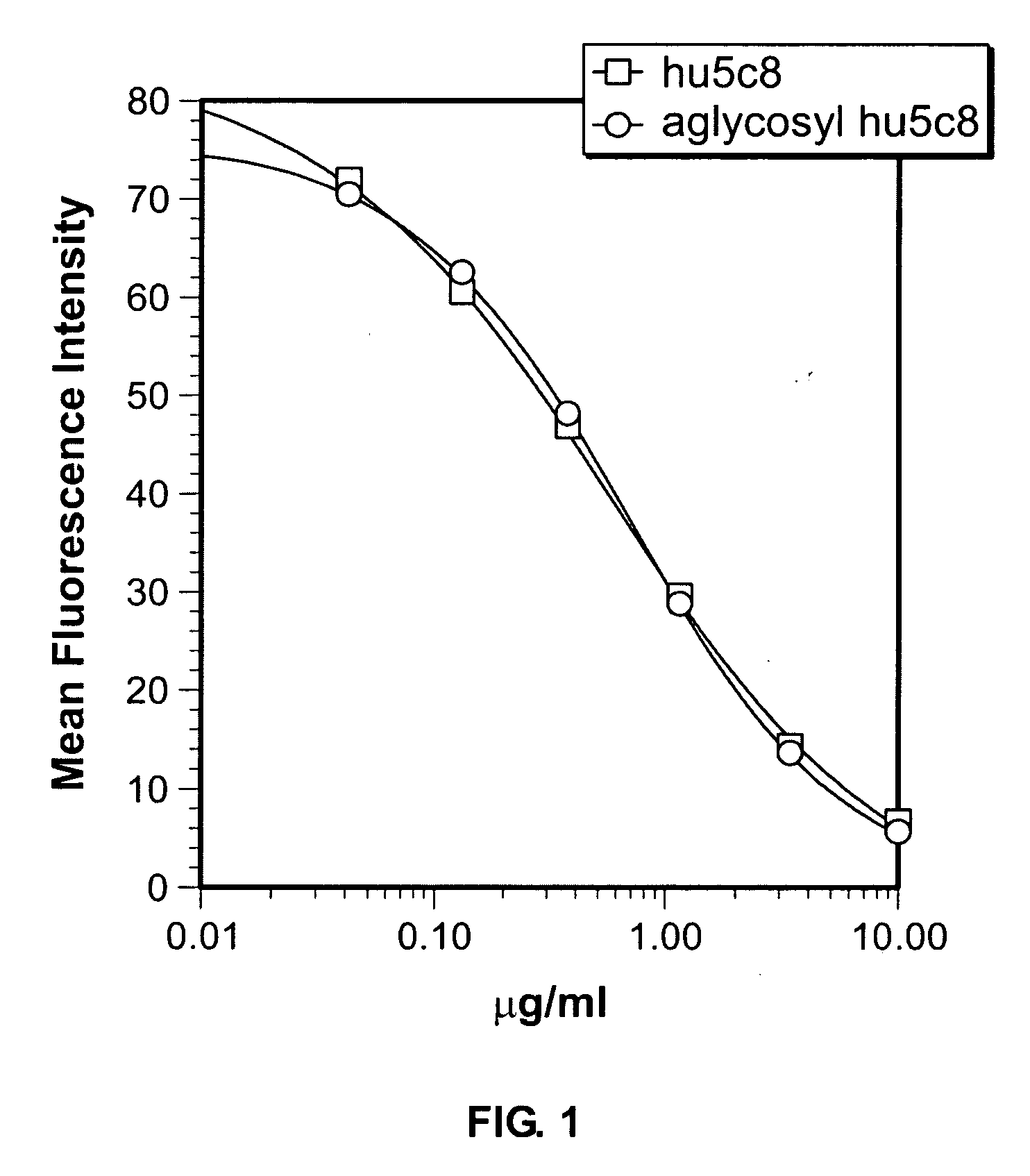Aglycosyl anti-CD154 (CD40 ligand) antibodies and uses thereof
a technology of cd40 ligand and anti-cd154, which is applied in the field of aglycosyl anticd154 antibodies or antibody derivatives, can solve problems such as inappropriate platelet activation, and achieve the effect of inhibiting immune cell activation
- Summary
- Abstract
- Description
- Claims
- Application Information
AI Technical Summary
Benefits of technology
Problems solved by technology
Method used
Image
Examples
example 1
[0160]1. Generation of Antibodies. The selection, cloning, and humanization of hu5c8 mAb have been described previously. See Lederman, 1992 and Karpusas, 2001, respectively. The hu5c8 mAb hyridoma is available from the ATCC (HB10916). The heavy chain glycosylation site mutation N298Q (N297 using EU numbering) was made in glycosylated hu5c8 mAb by unique site elimination mutagenesis using a kit from Amersham-Pharmacia Biotech (Piscataway, N.J., USA) following the manufacturer's recommended protocol. The resulting aglycosyl hu5c8 was stably expressed in NS0 myeloma cells and purified by Protein A and gel filtration chromatography. The cell line producing the aglycosyl hu5c8 antibody is available form the ATCC (PTA-4931). SDS-PAGE and analytical gel filtration chromatography demonstrated that the protein formed the expected disulfide linked tetramer.
[0161]2. CD154 binding assay. A FACS-based competitive binding assay was done on huCD154+ D1.1 cells (gift of Dr. Leonard Chess, Columbia ...
example 2
[0173]1. Humoral immune response to TT. Two independent studies were carried out in cynomolgus monkeys, using the same monkeys as in Example 1. Serum samples from each study were collected and whole blood for immunophenotyping was maintained at ambient temperature and analysis was performed on the day it was drawn.
[0174]This aglycosyl hu5c8 mAb study included two treatment groups. Group 1, consisting of four males and four females, received saline on day 1 and served as untreated controls. Group 2, consisting of two males and two females, received a single 20 mg / kg dose of aglycosyl hu5c8 mAb intravenously on day 1 (described above). Four hours after treatment, all animals received an intramuscular (IM) dose of 5 Lf (limes flocculating dose) of adsorbed TT. Blood was collected both pre- and post-treatment on day 1 and on selected days up to 190 days post-dosing. Lymph node biopsy samples were taken on day 15.
[0175]The glycosylated hu5c8 mAb study was comprised of five treatment grou...
example 3
[0203]1. Mice. BALB / c, SWR and NZB mice were purchased from The Jackson Laboratory (Bar Harbor, Me.). (SWR x NZB)F1 (SNF1) hybrids were bred in the animal facility at Biogen under conventional barrier conditions. Female SNF1 mice were used for all lupus studies. BALB / c mice were used for pharmacokinetic (“PK”) studies.
[0204]2. Antibodies. The MR1 hybridoma (ATCC #CRL-2580), which produces Armenian hamster anti-mouse CD154 mAb, was purchased from the American Type Culture Collection (Rockville, Md.).
[0205]3. Treatment Protocol. All injections were given by intraperitoneal route. The lupus study consisted of a control group of SNF1 mice that received PI.17 muIgG2a and treated SNF1 groups that received one of the chimeric anti-CD154 mAbs. A single dose of 500 μg of mAb once per week was given for the first six weeks, followed by a single injection of 500 μg monthly until death of the animal or termination of the study. Studies began when animals were ˜5.5 months of age and serum sample...
PUM
| Property | Measurement | Unit |
|---|---|---|
| concentrations | aaaaa | aaaaa |
| concentrations | aaaaa | aaaaa |
| emission wavelength | aaaaa | aaaaa |
Abstract
Description
Claims
Application Information
 Login to View More
Login to View More - R&D
- Intellectual Property
- Life Sciences
- Materials
- Tech Scout
- Unparalleled Data Quality
- Higher Quality Content
- 60% Fewer Hallucinations
Browse by: Latest US Patents, China's latest patents, Technical Efficacy Thesaurus, Application Domain, Technology Topic, Popular Technical Reports.
© 2025 PatSnap. All rights reserved.Legal|Privacy policy|Modern Slavery Act Transparency Statement|Sitemap|About US| Contact US: help@patsnap.com



